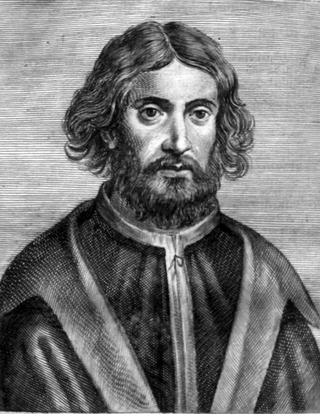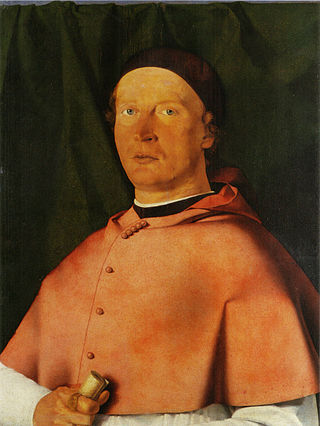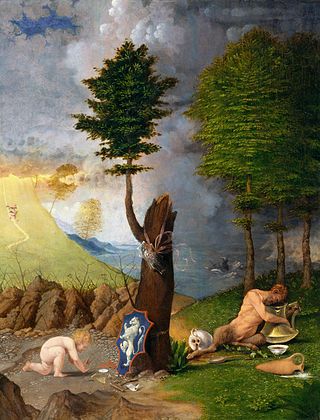
Lorenzo Lotto was an Italian painter, draughtsman, and illustrator, traditionally placed in the Venetian school, though much of his career was spent in other north Italian cities. He painted mainly altarpieces, religious subjects and portraits. He was active during the High Renaissance and the first half of the Mannerist period, but his work maintained a generally similar High Renaissance style throughout his career, although his nervous and eccentric posings and distortions represented a transitional stage to the Florentine and Roman Mannerists.

Giovanni di Niccolò de Luteri, better known as Dosso Dossi, was an Italian Renaissance painter who belonged to the School of Ferrara, painting in a style mainly influenced by Venetian painting, in particular Giorgione and early Titian.
Events from the year 1505 in art.

Cornelis Saftleven was a Dutch painter who worked in a great variety of genres. Known in particular for his rural genre scenes, his range of subjects was very wide and included portraits, farmhouse interiors, rural and beach scenes, landscapes with cattle, history paintings, scenes of Hell, allegories, satires and illustrations of proverbs.

Frans Francken the Younger was a Flemish painter and the best-known and most prolific member of the large Francken family of artists. Francken painted a range of subjects, producing large altarpieces for churches as well as smaller historical, mythological and allegorical scenes. His depictions of collectors' cabinets established a popular new genre of art in the era. Francken often collaborated with other artists, adding figures and narrative elements to scenes created by specialists in landscape, architectural scenes, and floral still life painting..

The Allegory of Faith, also known as Allegory of the Catholic Faith, is a Dutch Golden Age painting by Johannes Vermeer from about 1670–1672. It has been in the Metropolitan Museum of Art in New York since 1931.

Palma Vecchio, born Jacopo Palma, also known as Jacopo Negretti, was a Venetian painter of the Italian High Renaissance. He is called Palma Vecchio in English and Palma il Vecchio in Italian to distinguish him from Palma il Giovane, his great-nephew, who was also a painter.

The Portrait of a Young Man with a Lamp is an oil-on-canvas painting by the Italian High Renaissance painter Lorenzo Lotto, dating to c. 1506. It is housed in the Kunsthistorisches Museum of Vienna, Austria.

The Portrait of Bishop Bernardo de' Rossi is an oil-on-panel painting by the Italian High Renaissance painter Lorenzo Lotto, dating to 1505. It is housed in the National Museum of Capodimonte of Naples, southern Italy.

The Allegory of Virtue and Vice is an oil-on-panel painting by the Italian High Renaissance painter Lorenzo Lotto, dating to 1505. It is housed in the National Gallery of Art in Washington, DC, United States.

Pauwels Franck, known in Italy as Paolo Fiammingo and Paolo Franceschi, was a Flemish painter, who, after training in Antwerp, was active in Venice for most of his life. He is mainly known for his landscapes with mythological, allegorical and religious scenes. He worked in a Mannerist style showing the influence of Tintoretto, Veronese, and Bassano.

The Allegory of Vice is an oil on canvas painting by Correggio dating to around 1531 and measuring 149 cm (59 in) by 88 cm (35 in).

The Allegory of Virtue is an oil on canvas painting by Correggio dating to around 1531 and measuring 149 by 88 cm. It and Allegory of Vice were painted as a pair for the studiolo of Isabella d'Este, with Vice probably the second of the two to be completed. This hypothesis is since only one sketch survives for Vice, unlike Virtue, for which two preparatory studies survive, along with a near-complete oil sketch - this suggests Correggio had become more proficient after the difficult gestation of Virtue.
The Studiolo of Isabella d'Este was a special private study, first in castello di San Giorgio, later the Studiolo was moved to the Corte Vecchi apartments in the Ducal Palace in Mantua, designed by, and with a collection of art specially commissioned by Isabella d'Este.

The Entombment of Christ is a 1513–1516 oil-on-canvas painting by the Italian Renaissance artist Lorenzo Lotto, now in the Accademia Carrara in Bergamo. It originally formed the central predella panel to the artist's Martinengo Altarpiece at the church of Santi Bartolomeo e Stefano.

Portrait of Marsilio Cassotti and His Bride Faustina is a 1523 oil-on-panel painting by Lorenzo Lotto, now in the Prado Museum in Madrid. It is signed and dated "L. Lotus Pictor / 1523". It is the first known marriage portrait produced in Italy, inspired by prints from Germany and the Low Countries.

Saint Jerome in Penitence is an oil-on-panel painting by Italian Renaissance artist Lorenzo Lotto. Its signature ("Lotus") is fully legible, but the final number of the date is illegible, though it is usually dated to around 1506. It is now in the Louvre.

The Calvet Museum is the main museum in Avignon. Since the 1980s the collection has been split between two buildings, with the fine arts housed in an 18th-century hôtel particulier and a separate Lapidary Museum in the former chapel of the city's Jesuit college on rue de la République. It is one of the museums run by the Fondation Calvet.

Caritas is an oil on panel painting by German painter Lucas Cranach the Elder. The painting is kept in the Royal Museum of Fine Arts, Antwerp.


















